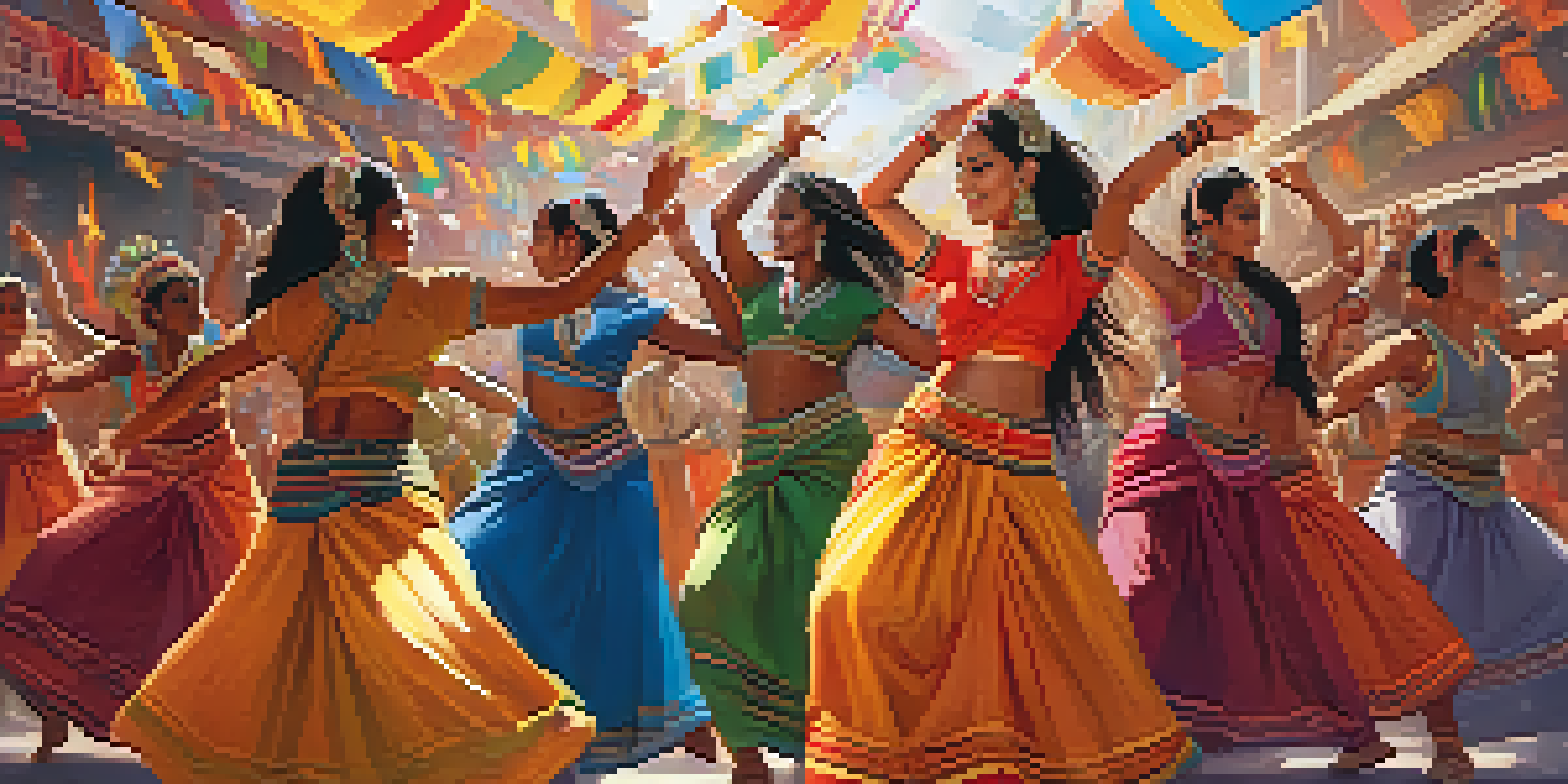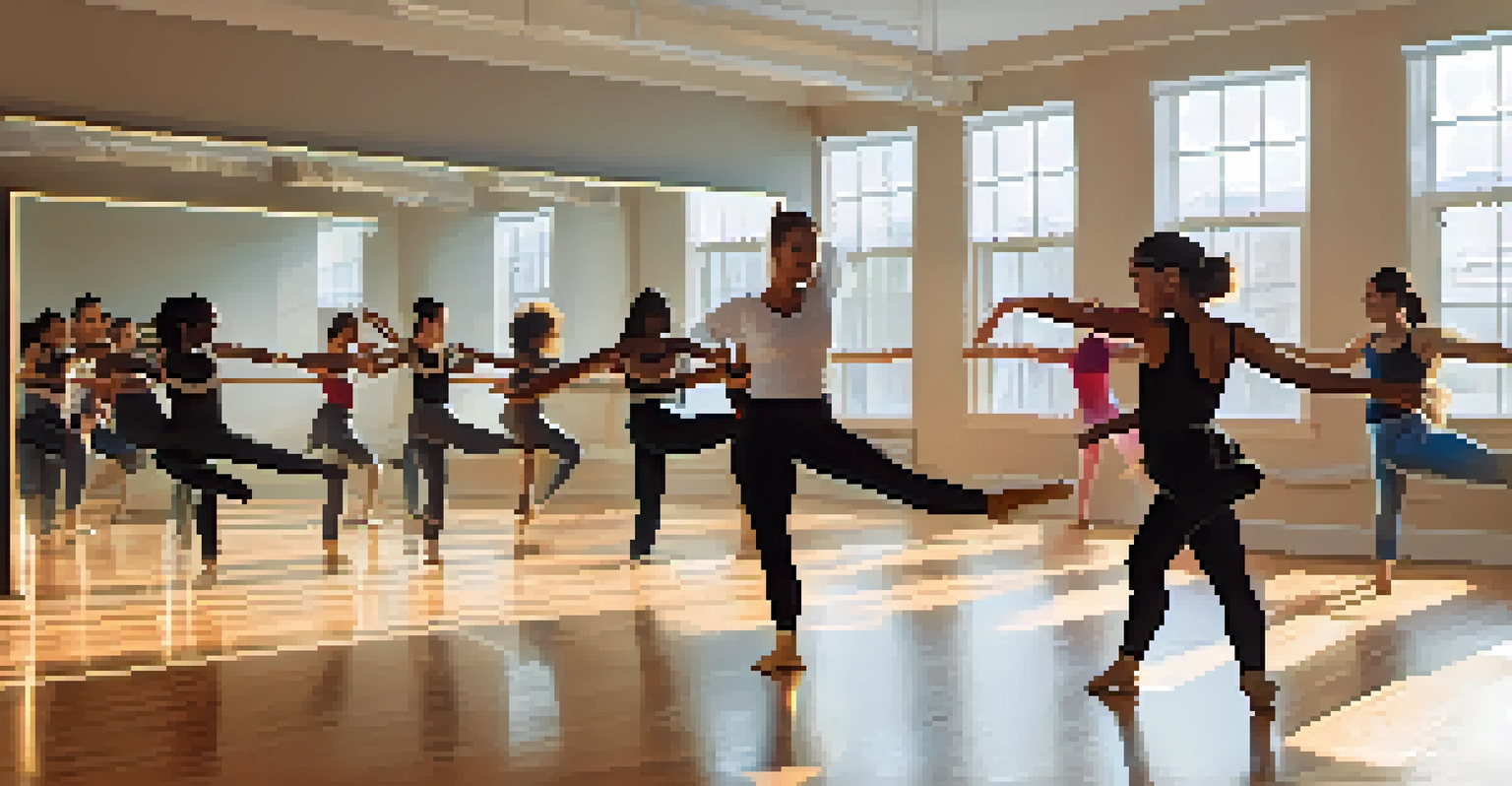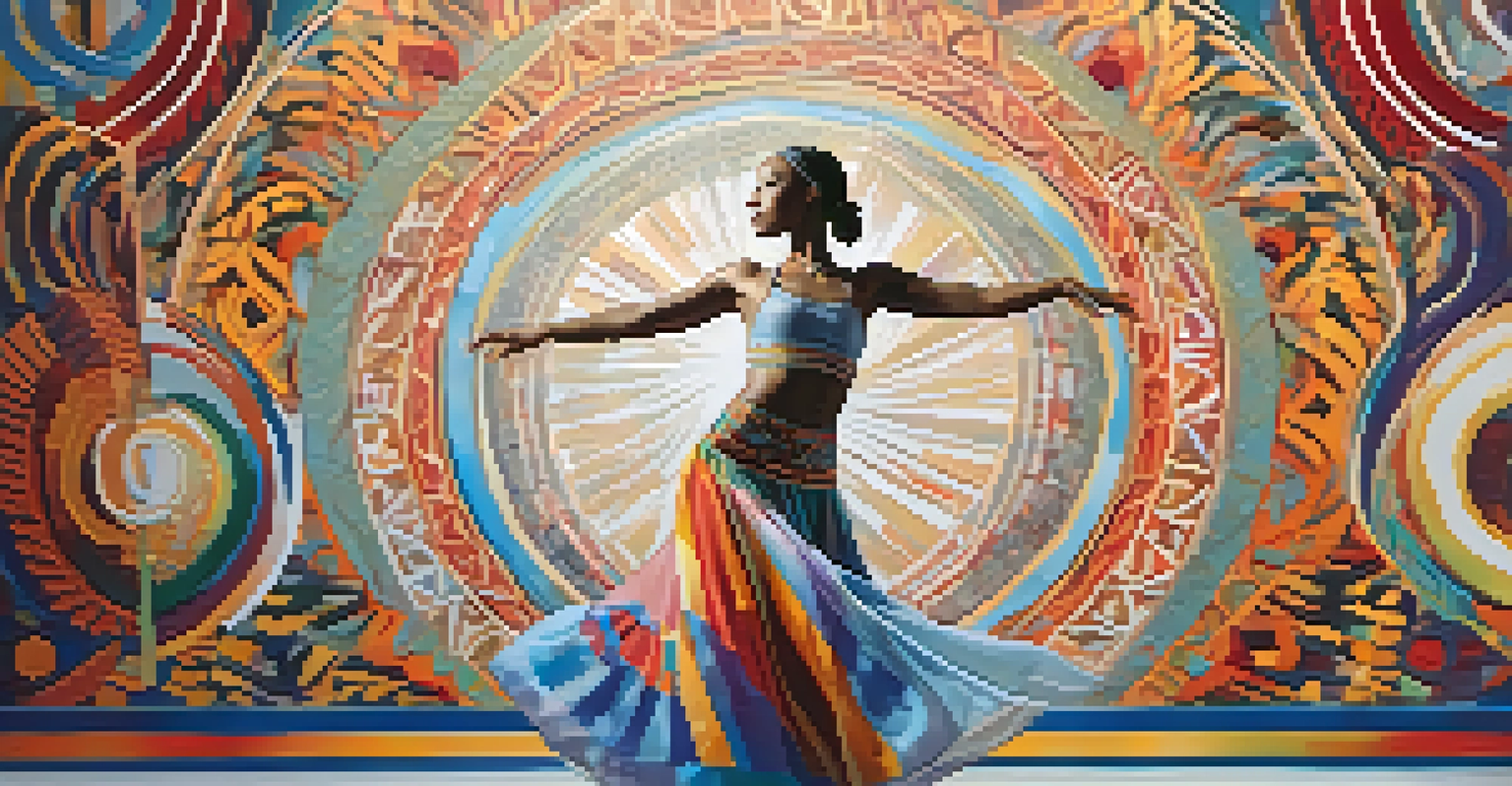Cultural Fusion: The Impact of Globalization on Dance Forms

Understanding Cultural Fusion in Dance Forms
Cultural fusion refers to the blending of different cultural elements, and in dance, this creates vibrant new forms. Just as a chef combines spices from various cuisines to create a unique dish, dancers incorporate movements and styles from around the globe. This not only enriches individual performances but also fosters a deeper appreciation for diverse cultures. For example, the fusion of hip-hop with traditional Indian dance has led to exciting new choreography that resonates with audiences everywhere.
Dance is the hidden language of the soul.
The beauty of cultural fusion in dance lies in its ability to break down barriers. When dancers from different backgrounds collaborate, they challenge stereotypes and encourage mutual understanding. Take the growing popularity of Afrobeat dance classes worldwide; they not only celebrate African culture but also invite diverse participants to engage and learn. This interaction creates a sense of community and shared experience, which is at the heart of effective cultural exchange.
Related Resource
Moreover, cultural fusion in dance often reflects broader societal changes. As globalization continues to connect people across the world, dance becomes a medium for storytelling and expression. It allows artists to communicate their experiences, dreams, and struggles, transcending geographical boundaries. This evolution is not merely about blending styles; it’s about creating a dialogue that celebrates both individuality and togetherness.
The Role of Technology in Dance Globalization
Technology plays a crucial role in the globalization of dance, making it easier for styles to cross borders. Social media platforms like Instagram and TikTok have turned dancers into global stars overnight, showcasing a variety of styles from around the world. For instance, viral dance challenges often incorporate elements from different cultures, encouraging users to learn and replicate moves that might have been unfamiliar to them. This instant access to diverse dance forms fosters curiosity and innovation among dancers.

Additionally, online dance classes and tutorials have democratized dance education. Now, anyone with an internet connection can learn styles ranging from ballet to breakdancing, often taught by experts from different parts of the world. This accessibility not only nurtures individual talent but also leads to the blending of techniques and styles, as students experiment with what they learn. It's like having a global dance studio right in your living room, where the only limit is your imagination.
Cultural Fusion Enriches Dance
Blending diverse dance styles fosters appreciation and understanding of different cultures.
However, it's essential to approach this technological influence with mindfulness. While the internet can spread awareness and appreciation of various dance forms, it’s vital to respect their origins and cultural significance. Dancers and choreographers should strive to honor the roots of the styles they adopt, ensuring that they engage with these traditions respectfully. This balance between innovation and respect is key to sustaining the authenticity of traditional dance forms amidst a rapidly changing landscape.
Celebrating Diversity Through Dance Festivals
Dance festivals around the world serve as vibrant platforms for cultural fusion. These events bring together artists from various backgrounds, showcasing their unique styles while encouraging collaboration. For example, the Edinburgh Festival Fringe features performances that blend contemporary dance with traditional folk styles, creating a rich tapestry of movement. Attendees not only get to enjoy diverse performances but also engage in workshops that promote cultural exchange and understanding.
Cultural fusion is not about erasing the origins of a dance form but about celebrating the richness that comes from blending different traditions.
Moreover, these festivals often highlight the stories behind the dances, allowing audiences to appreciate the cultural significance of each performance. This storytelling aspect fosters a deeper connection between the audience and the artists, creating a shared experience that transcends language barriers. For instance, a Brazilian samba performance at a local festival might inspire attendees to explore the history and cultural roots of the dance, promoting a broader appreciation for global traditions.
Related Resource
Additionally, dance festivals can serve as catalysts for social change. By celebrating diversity and promoting inclusivity, these events can challenge societal norms and stereotypes. When dancers from different backgrounds come together, they showcase the power of unity in diversity, inspiring others to embrace cultural differences. Ultimately, dance festivals become more than just entertainment; they are vital spaces for dialogue, learning, and celebration of our shared humanity.
The Impact of Cultural Appropriation in Dance
While cultural fusion in dance can be a beautiful expression of unity, it can also lead to cultural appropriation. This occurs when elements of one culture are adopted by another, often without proper understanding or respect for their origins. For example, when traditional Indigenous dance moves are performed without acknowledgment of their significance, it can feel disrespectful to the culture they originate from. It's crucial to navigate this landscape carefully, ensuring that appreciation does not cross into appropriation.
Understanding the difference between cultural appreciation and appropriation is key for dancers and choreographers. Appreciation involves learning about and respecting the culture from which a dance style originates, while appropriation often involves taking aspects of a culture out of context. Dancers should strive to engage with the cultures they draw inspiration from, seeking to collaborate with artists from those backgrounds. This approach not only enriches their performances but also fosters genuine connections and mutual respect.
Technology Expands Dance Reach
Social media and online classes democratize dance education, allowing global access to various styles.
Conversations around cultural appropriation are increasingly important in the dance community. As globalization brings diverse dance forms into the spotlight, it's essential to address the complexities that arise. By fostering open dialogue about these issues, dancers can work towards a more inclusive and respectful environment that honors the rich histories and traditions behind each style. This awareness ultimately contributes to a more harmonious cultural landscape in the world of dance.
Dance as a Reflection of Global Societal Changes
Dance is often a mirror reflecting societal changes, and globalization has amplified this phenomenon. As people migrate and cultures blend, dance evolves to capture the zeitgeist of contemporary society. For instance, the rise of urban dance styles like krumping and waacking speaks to the experiences and struggles of marginalized communities, using movement as a powerful form of expression. These styles not only entertain but also tell stories that resonate with broader societal issues.
Moreover, dance often serves as a platform for social commentary, addressing themes such as identity, race, and gender. Choreographers are increasingly using their art to provoke thought and inspire change, blending traditional movements with modern themes. For example, contemporary dance pieces that incorporate elements of hip-hop may explore issues of systemic inequality, inviting audiences to engage with these critical conversations. Dance becomes not just a performance but a form of activism, challenging viewers to reflect on their own perspectives.
Related Resource
As globalization continues to shape our world, the narratives told through dance will also evolve. Dancers and choreographers play a vital role in this process, using their art to capture the complexities of the human experience. By embracing cultural fusion and addressing societal changes, they contribute to a dynamic landscape that celebrates diversity while advocating for understanding and empathy. This interplay between dance and society ensures that the art form remains relevant and impactful in an ever-changing world.
The Future of Dance: Embracing Cultural Fusion
As we look to the future, the potential for cultural fusion in dance is both exciting and promising. With globalization continuing to connect people across the globe, dancers have unprecedented opportunities to explore and experiment with various styles. This evolution will likely lead to the emergence of new hybrid forms that blend techniques and movements in innovative ways. Imagine a performance that seamlessly integrates ballet, hip-hop, and traditional African dance—this is the future of dance that awaits us.
However, as we embrace this fusion, it’s essential to maintain a commitment to cultural integrity. Dancers and choreographers should prioritize education and respect for the traditions they draw from, ensuring that they honor the roots of each style. This balance between innovation and respect will help sustain the authenticity of cultural expressions, allowing them to thrive in a globalized world. Collaborations that involve artists from diverse backgrounds can pave the way for meaningful exchanges that enrich the dance community as a whole.
Dance Festivals Celebrate Diversity
Dance festivals serve as platforms for cultural exchange, showcasing unity and inspiring social change.
Ultimately, the future of dance lies in our collective ability to celebrate diversity and foster inclusivity. By encouraging dialogue and understanding, we can create a vibrant dance landscape that honors the richness of various cultural traditions. As audiences and artists alike continue to explore the beauty of cultural fusion, dance can remain a powerful force for connection, expression, and celebration in an ever-evolving global society.
Conclusion: The Harmonious Blend of Cultures Through Dance
In conclusion, cultural fusion in dance underscores the beauty of human connection. As globalization continues to influence our world, dance becomes a powerful medium for storytelling, expression, and collaboration. The rich tapestry created by blending diverse styles not only entertains but also fosters understanding and appreciation for different cultures. Each performance carries the weight of history, identity, and shared experiences, making dance a universal language that transcends borders.
While the journey of cultural fusion is filled with opportunities, it also poses challenges. Recognizing the fine line between appreciation and appropriation is vital for dancers and choreographers. By engaging with the cultures they draw inspiration from, they can ensure that their work celebrates authenticity and respect. This approach not only enriches their art but also contributes to a more inclusive dance community.

As we move forward, let us embrace the harmonious blend of cultures through dance, celebrating the diversity that makes our world vibrant. By fostering open dialogue and collaboration, we can ensure that dance continues to evolve as a reflection of our shared humanity. In doing so, we create a future where every dancer's voice is heard, and every culture is honored, making the dance floor a true melting pot of creativity and expression.